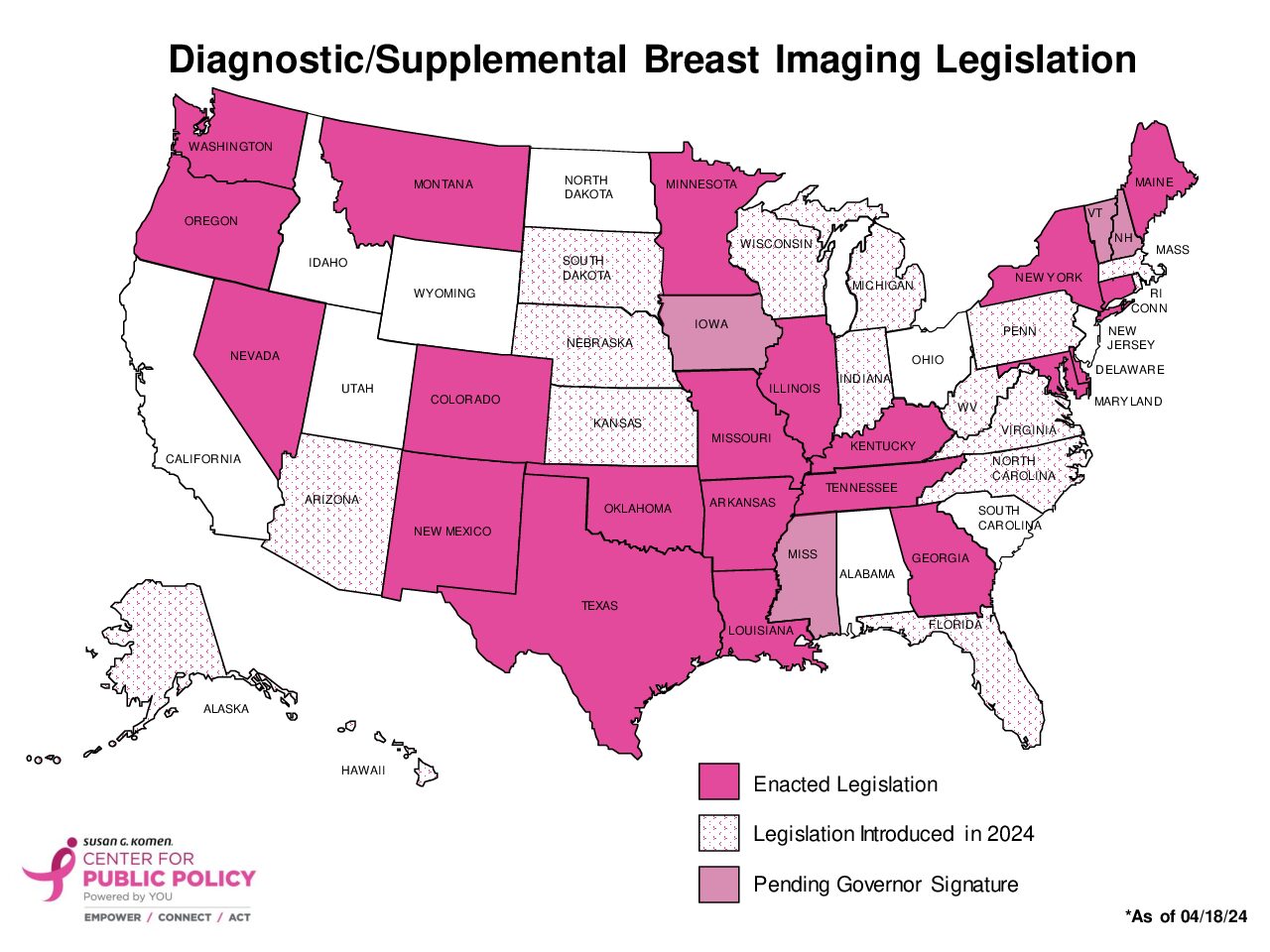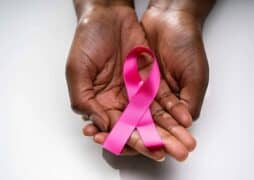What the new USPSTF draft recommendations mean, and how we can help
By Victoria Wolodzko Smart, senior vice president of mission at Susan G. Komen
The U.S. Preventive Services Task Force recently released their updated draft recommendations for breast cancer screening, which is a meaningful step in the right direction. On behalf of all of us at Susan G. Komen, we were relieved to see the recommendation that all women get screened for breast cancer every other year starting at age 40.
As an advocate and leader in the breast cancer community, I am grateful the news cycle has brought to light a desperately needed conversation that must remain top of mind if we’re going to move the needle in breast cancer. However, soon after the announcement, my phone and inbox were inundated with one question in particular: “Wasn’t it always 40?”
That’s a great question with a complex answer. It’s also an unfortunate example of how confusing health care is for most Americans.
While the USPSTF has recommended breast screening begin at age 50 since 2009, the idea that women should start receiving mammograms at age 40 has been the general consensus in the medical, scientific and breast cancer communities for decades—and, thanks to the PALS Act, women with health insurance are covered to do so when they turn 40.
But, we now know that breast cancers in younger women are more likely to be fast-growing, higher grade and hormone receptor negative. Black women are more likely to be diagnosed younger with more aggressive types of breast cancer.
This begs another question: Is 40 early enough, and is every other year frequent enough? Who may be left behind and become one of the many who experience inequities in their outcome of breast cancer?
While these are only draft recommendations from the USPSTF, let’s discuss the gaps that still need filling before the final recommendations are published, and how you can play a role in saving lives—including your own.
ONE-SIZE-FITS-NONE
Simply put, a one-size-fits-all approach to screening recommendations creates vulnerable populations. True personalized medicine is what will save lives. It means looking at everyone for who they are, their experience, their family, how they live and where they live. And these experiences are not properly reflected in the bulk of breast cancer research, historically based heavily on white individuals.
This is why Komen works tirelessly to ensure breast cancer research includes all communities and is beneficial to everyone. We’ve known for years that Black women are 40% more likely to die from breast cancer than white women, and that it’s the most common form of cancer among Hispanic/Latina women. And while the USPSTF calls for more evidence to better understand whether Black women could benefit from different screening strategies, Komen continues to urge women to discuss screening plans with their provider and develop a plan based on their personal risk, especially as these new draft recommendations are only for women of average risk.
We’ve also made enormous strides in understanding breast cancer risk and genetic mutations, which support the idea that age 40 may not be early enough for some women’s first mammogram.
Women under age 40 diagnosed with breast cancer often have a worse prognosis than older women. In fact, it’s the leading cause of cancer death among women in the U.S., ages 20 to 39. While breast cancers in younger women can be more aggressive, this population also faces early menopause, loss of fertility, pregnancy after treatment and overall higher stage of breast cancer at diagnosis. Breast cancer cases in women under 40 are less common (about 4 percent), but there are a variety of known factors that increase their risk and therefore, often warrant a screening earlier in life.
But most important—and what has been missing from this conversation—is that, while a screening mammogram is often the first step toward diagnosis, it’s not the only step.
Diagnostic breast imaging—including diagnostic mammography, breast ultrasound and breast MRI—is required to rule out breast cancer or confirm the need for a biopsy. And while these tests are typically covered by insurance, they come with significant out-of-pocket cost. For some at high risk of breast cancer, screening mammography is not as effective in catching early-stage breast cancer, and supplemental breast imaging is recommended in addition to annual screening mammography. Since this imaging is coded as diagnostic, it also typically comes with significant patient cost.
Any conversation about early detection must include the need to address gaps that exist in access to diagnostic services
A MATTER OF LIFE OR RENT
The FDA’s new nationwide breast density notification standard (taking effect Sept. 10, 2024) requires providers to let women know if they have dense breasts and discuss if they may need additional tests to detect breast cancer. Breast cancer survivors and those deemed to be at high risk also often require additional testing like diagnostic imaging, not just traditional screening mammography. However, the majority of women in this country are faced with significant out-of-pocket costs when they must use testing beyond screening mammography.
This causes countless women to choose between putting food on the table, paying rent or scheduling additional diagnostic tests that could cost them thousands of dollars in out-of-pocket costs. A Komen-commissioned study found the average out-of-pocket cost is $234 for a diagnostic mammogram and $1,021 for a breast MRI—at times as high as $2,600. These costs are a common barrier to care, leading to delayed diagnosis, higher treatment costs and worse health outcomes.
In fact, 63% of people who received financial assistance from Komen last year needed help with housing, utilities and bills. The financial burden, no matter the new notification standard, still poses a life-threatening barrier and a risk to women whose breast cancer may only be detected once it’s reached a more advanced, less treatable stage.
Mammograms only get you one step closer to knowing whether you have breast cancer or not; it’s easy for women to be left behind, even with their yearly screenings. Yes, as the USPSTF stated, additional screening and testing may very well save 19% more lives—but only if they can afford to get to a diagnosis. Early detection must include coverage for needed diagnostic and supplemental tests if we’re going to truly save lives from breast cancer. Cost is keeping people from finding out if they have a chance to survive.
This is also such an important part of Komen’s policy and advocacy work. For years, we’ve chipped away at this issue, state by state, as diagnostic testing is so key to early detection. And we’ve made progress—but the cost is still taking lives from us. Working with state and federal policymakers, our Center for Public Policy has introduced legislation that would eliminate patient cost for this essential breast imaging. While we are still waiting for movement on federal legislation, as of today, 13 states have signed bills into law removing the financial barriers for thousands of people who require additional breast imaging yet can’t afford it.
TIME IS LIFE—AND OF THE ESSENCE
Most women have been told that mammograms are an annually recommended screening. This, too, caused confusion as USPSTF has recommended biennial mammograms for average-risk women since 2009. This will once again create a discrepancy (and much confusion) between the USPSTF’s guidelines and many health care providers, professional groups and patient advocacy organizations who advocate for annual mammograms.
This two-year period between screenings will undoubtedly allow breast cancers to go undetected, with cases resulting in later-stage detection. It will also create gaps in access to care for younger women, placing more lives at unnecessary risk.
As we learned during the pandemic, cancer screening rates declined as much as 87%, according to data in 2022 (Source: CDC). As we work to urge women to catch up on their screenings, we’ve witnessed the devastating impact a single year can have when patients delay care. We must also acknowledge that low breast cancer screening rates existed well before the pandemic, notably among women living in rural areas and women of color. Whether caused by cost, accessibility or access to care, several populations are suffering.
HOW THE PALS ACT PROTECTS SOME, NOT ALL WOMEN
Today, thanks to the Protecting Access to Lifesaving Screening (PALS) Act, all women with health insurance are guaranteed no-cost access to annual screening mammography, and approximately 22 million women in their 40s will continue to see their annual screening covered.
Komen has been a vocal supporter and champion of this critical legislation since 2009 and every year it has come up for an extension. At the end of 2022, the PALS Act was extended through 2025. We stand ready to support our champions in the U.S. Congress to extend these vital protections beyond 2025 if needed. While this doesn’t solve the problem for everyone, it was a critical step in moving toward better protections.
To help fill the gap, Komen also is a supporter of the National Breast and Cervical Cancer Early Detection Program that provides care for uninsured women.
WHAT WE NEED NOW
We cannot overstate the benefits of Americans clearly understanding their risk of breast cancer and determining the right approach to screening and diagnosis alongside their doctors. Earlier detection and access to timely, high-quality care must be equitably provided to all. When public health is a real priority, we have a healthier country, we have a healthier economy, we lessen the economic burden on families and on our health care system.
To have a success story:
- We need annual mammograms—not every-other-year.
- We need personalized health care for all—not a one-size-fits-all approach in age and demographic.
- We need coverage for all necessary diagnostic and supplemental breast imaging at no cost to patients to deliver on the promise of early detection.
And we need you.
As of today, countless lives hang in the balance as we await the USPSTF’s final recommendations, which have the potential to save more lives and change the face of breast cancer as we know it.
We must do better so that people can live longer. So, how can you help today?
- Sign up to be an Advocacy Insider with Komen to stay in-the-know about current legislative and advocacy actions. Further our efforts to keep the PALS Act in place, push for better diagnostic testing coverage, and so much more.
- Be your own advocate. Learn about your risk, discuss your screening needs with your provider, challenge your insurance and be aware of your rights! Knowledge is power.
- Lastly, anyone needing help accessing a mammogram or diagnostic services can call Komen’s Helpline at 1-877-GO-KOMEN.
Let’s get this right so we can save more lives from breast cancer.



